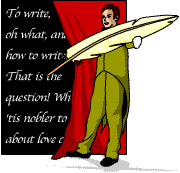Writing Right with Dmitri: Stealing from RL
Created | Updated Jan 15, 2012
Words, words, words. That's what we're made of. Herewith some of my thoughts on what we're doing with them.
Writing Right with Dmitri: Stealing from RL
Part One: Borrowed Characters

Have you ever had a friend who enthused about a favourite author? 'He/she's writing my life!' they insist.
No, friend, the author is writing his/her life. He (or she) is drawing on personal experience to fill in the details of what WS Gilbert called 'an otherwise bald and unconvincing narrative'. You have to be careful when writing about people, though. They might get mad at you. Thomas Wolfe wrote You Can't Go Home Again. Well, Asheville, North Carolina is rather proud of its famous son, but Mr William Faulkner ruffled quite a few feathers in Mississippi. Nelle Harper Lee drew on her family, friends and neighbours for the characters in To Kill a Mockingbird, even though she claimed she didn't. (Her father was a liberal lawyer and member of the legislature. She was a tomboy. Her next-door neighbour was the infant Truman Capote. We rest our case.)
How well-received this sort of thing is going to be depends on how you've portrayed the people, we suspect. Your neighbour may be touched to find himself described as a kindly old codger, but turning him into the local serial killer may have him googling the name of a good civil attorney. Best to mix and match, and change the names to protect the guilty (and you).
I recently wrote a story about my sister doing her homework when she was nine years old. I described how she asked me to spell the word 'snuck' for a book report, and made mild mock of the fact that she counted slowly. Elektra snuck around behind my back and sent the link to my sisters. Both of them enjoyed the blast from the past. The sister who was the subject of the story replied that while she hadn't written 'snuck' in a long time, her students laughed at her, because even though she's a physicist, she still has trouble adding. Our baby sister said that she could 'just hear' our sister blaming me for messing up her book report. Know your audience.
'My dear Copperfield,' said Mr. Micawber, putting out his hand, 'this is indeed a meeting which is calculated to impress the mind with a sense of the instability and uncertainty of all human – in short, it is a most extraordinary meeting. Walking along the street, reflecting upon the probability of something turning up (of which I am at present rather sanguine), I find a young but valued friend turn up, who is connected with the most eventful period of my life; I may say, with the turning-point of my existence. Copperfield, my dear fellow, how do you do?'
I cannot say – I really cannot say – that I was glad to see Mr. Micawber there; but I was glad to see him too, and shook hands with him, heartily, inquiring how Mrs. Micawber was. – Charles Dickens, David Copperfield
Now, is that any way to describe your own father? Yet John Dickens was his son's model here. Poor father. Poor son. (But for different reasons.)
What do we borrow from our acquaintances? A rag, a bone, and a hank of hair? A turn of phrase, a conversational gambit? How about a childhood speech defect and an article of clothing? A web writer claims that JM Barrie not only modelled Wendy Moira Angela Darling after a young friend of his (the poor child died at the age of six), but gave Wendy the little girl's cloak and a made-up name. According to the story, little Margaret called Barrie her 'fwendy-wendy'. The name Wendy didn't exist back then, but lots of women have been named after the delightful character in Peter Pan. Personal experience counts for a lot in creating our fictional worlds, and can have far-reaching effects.

Joe Connelly and Bob Mosher, two US television writers in the 1950s, had children (seven and two, respectively). To create their iconic series about growing up, called Leave It to Beaver, they followed their kids around with notebooks, writing down what they said. It must have driven the kids to distraction, finding themselves parodied in prime-time. Beaver, the grade-school Everyman, got his name from an old merchant-marine buddy of Connelly's and his personality from Connelly's eight-year-old son. I couldn't find a record of who Eddie Haskell was based on. Eddie was the slimy character in the story – a hypocritical teenager who sucked up to the grown-ups, then made fun of them behind their backs. Eddie's character was so memorable, he became a catchphrase, a type. There's even a blog article offering advice for HR departments that warns against hiring 'Eddie Haskells'. Now, that's an enduring character, but not one you'd want to admit to being.
Where do you get your characters? From your head, of course. Also from the people you meet every day, remember from childhood, or observe on the train.
That man over there is having the funniest conversation with his Alsatian. Quick, where's my notebook? Do you think he'd sue me?
Writing Right with Dmitri Archive
